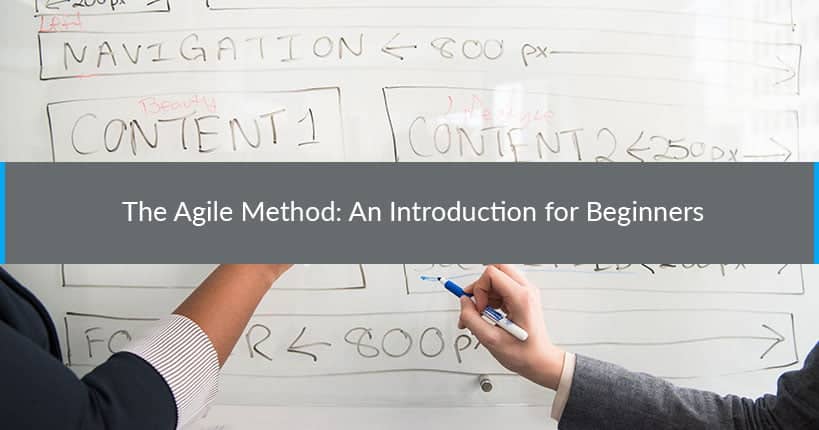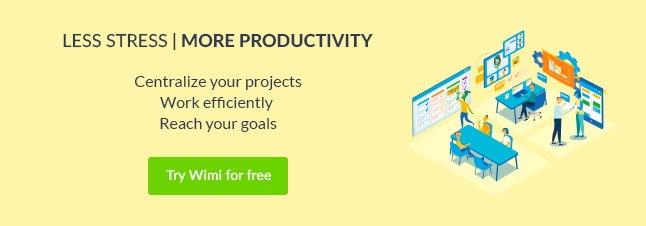In project management, there are a number of work methods that ensure the efficiency and success of your projects. One of the most well-known is without a doubt the agile method, which combines multiple project management approaches. What do they have in common? The agile method is more flexible than a traditional project management method and places client satisfaction at the heart of the project.
Originally created for web and IT development projects, the agile method has become very popular and is used in a variety of companies, in diverse industries.
Definition
The agile method is a flexible, reactive and adaptable approach, allowing you to prioritise teamwork and communication between the client and the team. This allows plans to be changed as well as giving the project more flexibility. This provides quick, high-quality results that take into account the client’s needs.
Background to the agile method
In the 90s, tech-related projects suffered an alarming failure rate, notably due to the differing expectations of clients and the solutions presented. IT techniques are constantly evolving at a rapid rate which has rendered the traditional waterfall development method inapplicable.
In light of this, 17 software development experts decided to come together in the US, in 2001, in order to combine their methods to define a new way of developing software. Among them are Ward Cunningham, the inventor of the Wiki Concept, and Ken Schwaber and Jeff Sutherland, the founders of Scrum. From this, the agile method was developed.
The agile method
The following passage examines the agile method. It determines the 4 values and the 12 fundamental principles to follow if you choose to adopt this project management method.
The agile approach encourages you to value:
- The team: Individuals and the interactions rather than the processes and the tools;
- The application: Operational features rather than a detailed explanation,
- Working with the client rather than contractual negotiation,
- Adapting to changes rather than following a rigid plan,
12 general principles that stem directly from these values:
- Client satisfaction is the absolute priority,
- Suggestions for change should be received well, even if these are suggested late in the project,
- An operational version of the software must be delivered regularly,
- The team and the client should work together daily throughout the project,
- Work with a motivated team. Trust and support your team and create a pleasant working environment.
- Face to face communication should be prioritised as it is the most simple and effective method to convey information.
- To evaluate the progress of the project, ensure that each feature is operational.
- The project’s progress should be steady and constant.
- Make sure to maintain technical excellence and a good design.
- Keep it simple and to the point.
- Team accountability improves the quality of the work,
- The team should constantly be adjusting its behaviour and methodology to increase efficiency.
How does it work?
With the traditional cascade method, the team receives detailed specifications from the client and then plans, coordinates and executes the entire project until it is delivered to the client on time. The problem is that the needs or expectations of the client may have evolved, the market may have changed or the fashion may have gone out of style. Consequently, the project is no longer adapted and the client is no longer satisfied. The team then has to start all over again. You are losing time, money and your client relationship is suffering. Furthermore, what’s to say this won’t happen again with the second version?
By choosing the agile method, you can avoid this. Why? Because client satisfaction is the absolute priority. To do so, communication with the client is prioritised throughout the project in order to take into account the evolution of their needs. The project’s team is therefore able to adapt the project according to the client’s requirements because the plan is not rigid.
With the agile method, the project is divided into sub-projects. Every sub-project is validated by the client before moving onto the next stage, until the project is finalised. This flexibility offers room for change in case of unforeseen factors. Above all, you don’t lose time planning ahead in detail.
Advantages and disadvantages
5 advantages of agile mode:
- Flexibility – This is the major asset of this method. The project is organised in a way that allows for unforeseen factors. This facilitates the team’s reactivity.
- Communication with the client – The client is involved throughout the project. They collaborate and communicate every day with the team. Furthermore, you are certain that the client is happy with the project and you are building a strong relationship with eachother.
- Better overview: The fact that the project is divided into sub-projects encourages a better overview over the progress. The client and the team can track the progress of the project and understand the next steps.
- Budget control: At the end of each of the project’s stages, you know your budget and you can decide whether or not to pursue the project depending on your financial situation.
- More team independence: Delegating responsibility to your team members is an essential aspect of the agile method. Your team is more independent and provide better quality work.
In terms of disadvantages, 4 can be identified:
- Lack of documentation: Face-to-face communication is preferred which sometimes makes it difficult to keep track of progress. This may be problematic if the team working on the project changes.
- The client’s availability: The agile method requires the constant and regular involvement of the client in the project. They therefore have to be available and have the desire to invest themselves completely in the project.
- Difficulty having a budget overview: The team and the project’s flexibility to be modified will also have an impact on the total cost and this will be difficult to predict.
- The method may not be applicable to all companies: The fact that the method requires team collaboration may make the agile method unsuitable to implement in a company with a very hierarchical structure.
You are now ready to start using the agile method. For more information, discover how to work in project mode (article link).










